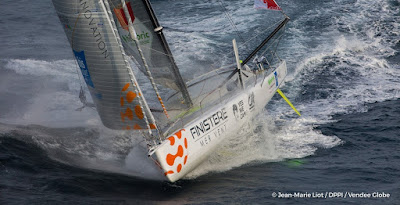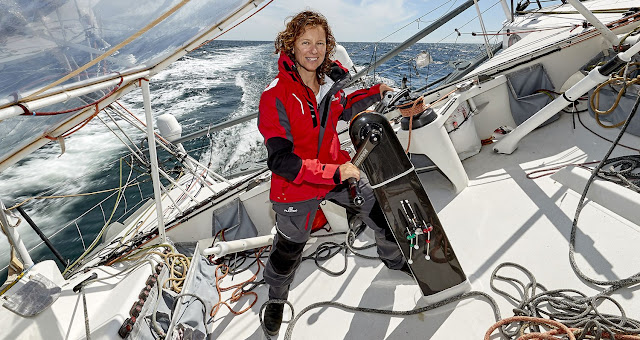Monday, November 30, 2020
VENDÉE GLOBE: ISABELLE
Monday, November 23, 2020
ELAN GT6 STYLED BY PORSCHE
Luxury and power, it is how they describe the GT6 and the Porsche link suggests just that, but the boat power and performance deny that association even if the looks are well sorted out with the big freeboard being very well disguised by a sculptured hull with integrated "windows". The yacht looks like a mini maxi yacht, and that's precisely what they want it to look like. Two powerful associations.
 |
| Solaris 47 |
12,450kg is a very good displacement for a 47fter with this type of interior, similar to the Solaris 47 displacement (12,600kg), on a hull that is beamier (4.49m - 4.36), has a similar hull length (14.33m - 14.35) and a close LWL ( 13.50 - 13.40m).
Both boats have the beam brought back to the transom but the design is different having the Elan a much more marked chine than the one on the Solaris, that is also higher on the hull allowing more heel before being active.
Now that I cleared that point it is only fair to say that Elan GT6 has some very well-designed features like the fixed cockpit tables that are not very intrusive when closed and offer handlebars and feet support for the ones that are seated on the cockpit when the boat is heeled. Handlebars are something that is very well treated not only on the cockpit but as well as in the boat interior.
 |
| Elan GT6 |
The Bimini is huge and with the sprayhood cover all the cockpit at the cost of a less efficient main control system, that is over the cabin, without a traveler (that is optional) and with the two blocks fixation points not as separated as in some other boats, allowing only a mainsail limited trimming.
The running rigging is, unfortunately, the one that is more common today with only four winches that are well located, two of them electric. On the positive side, it comes with two small genoa tracks instead of the more common self-tacking traveler, allowing the use of a small genoa.
 |
| Solaris 47 |
The space behind the wheels is not big. Enough, but not optimal and that's due to two big cabinets behind that serve as seats, one with a freezer inside, the other with a nice integrated grill. Certainly two nice touches for enjoying life while cruising.
 |
The interior that Elan says " delivers a luxurious experience" is of good quality if we take into account what test sailors said.
I had not the opportunity to see this one and with this Covid shit over Europe, I don't know when I will be able to do so, because boat saloons have been canceled everywhere, but I have seen other Elan and they have a good quality interior, not at the same level as the more expensive boats, but certainly better than mass production brands. I would say at the same level as Dehler.What really seems wrong is a stove without an opening above or without a mechanical smoke (and fat) extractor. The same happens on the smaller GT5 but they can open a small "window" on the plexiglass surface, at the owner's request, except that here it would have to be much higher and I doubt that it would be practical to use due to that. A mechanical extraction system should have been thought of as standard on this yacht.
In the Sailing Today test they refer that "there is space for a generator and watermaker aft of the engine under the cockpit sole" but that space seems to be occupied by a large and deep central cockpit locker and it is not shown in any of the detailed "walk through" videos neither in any photos on the brand site or magazines. I also haven't seen on the photos and several videos any access to such a space. Quite a mystery that I would certainly be interested in unveiling, when I will have the opportunity to visit the boat.https://www.sailingtoday.co.uk/featured/boat-test-elan-gt6/
The reason why that space is odd has to do with the space occupied by a big toilet that enters obtrusively in the saloon area and does not allow for a nice sized chart table/sofa with two seats, one on each side, a solution that is used on many boats and that allows a multi-functional space.
Sure, it makes production cheaper, but what one would gain in comfort, space, and beauty, more than makes for the difference in price. This has not to do with the designer but with a brand policy to have minimal changes between the two cabin and three cabin versions, that I believe is wrong and that takes away cruising potential to several boats on Elan line and none more than on the E5 that could have a good galley on the 2 cabin version, instead of an under-dimensioned one. I am quite sure that has a negative effect on sales, much bigger than what the small increase in price would have.
Not a boat for someone that is looking for a true performance cruiser ( a Porsche) but an option for the ones that are looking for a main cruiser, the type that is usually produced by big brands, wants a better-built sailboat and also one with a better performance upwind in medium to heavy weather, at a higher price (369 000 euros without VAT) but not as higher as other options like for instance a Saare 46, but not far of the price of a Grand Soleil 46LC (379 000) even if the GS is a foot smaller.
Saturday, November 21, 2020
WILL LE CAM BE ABLE TO DO IT AGAIN ON SAINT HELLEN HIGH?
 |
| Linkedout, Ruyant's boat |
 |
| Hugo Boss, Thomson's boat |
 |
| Apivia, Dalin's boat |
 |
| Yes we Cam, Le Cam's boat |
Thursday, November 19, 2020
"YES WE CAM !" LE CAM'S IMOCA
Monday, November 16, 2020
VENDÉE GLOBE: A WOMAN AS FAST AS THE FASTEST MEN

Saturday, November 7, 2020
VIRGIN MOJITO 650
On a small cruising boat, more than on a bigger one, it makes sense to maximize hull form stability and interior living space and that's what Mojito 650 is about. But its hull is not only designed to maximize space but also to offer maximum performance downwind. It is the one of the Maxi 650, the mini-racer that is a winner in the mini-class races.
It has a 1.60m draft on the fixed keel and 0.80/1.85m on the swing one. The superior area upwind on the racing boat, on a lighter boat, indicates a bigger B/D but both boats are certified as class C boats. That is not a good reference in what regards final and safety stability. Unfortunately, neither IDB neither David Raison, the designer, disclose the ballast in any of the boats.
It is very difficult to reunite on such a small boat the qualifications to have it certified as a class A boat, but not impossible as the Mini-racer Pogo3 demonstrates. I find odd the Virgin Mojito 650 not to be certified on at least Class B and certainly if I was interested in buying one I would certainly want to know more about the boat stability, particularly about RM at 90º, final stability, AVS and downflooding angle.
I have no doubt that the overall stability, due to the huge beam (3.0m) and the shape of the hull, with its rounded bow, will be a good one for a hull with 6.50m length, and I have no doubt that it will have an excellent performance downwind, a very good one while beam reaching and even a satisfactory one upwind with the deep swinging keel (1.85m) help, at least on a flat sea.
Of course, due to a lesser B/D the cruiser will not have such a good performance but I believe that even so, it would not be a bad one if we take into account the boat's large beam and understand that performance will degrade rapidly if waves are to be met, especially short-period waves, like the ones that are common on the Med or on the Baltic.
We will see if they manage to materialize that potential on the prototype that has already the hull and the cabin built, and it looks good!
About the way it is built, that at the IDB shipyard is normally a good one, I cannot say much because they don't use the habitual core material but they say this boat is"eco-innovative" and use a core made with linen, PET and cork.
Here you can see the racing version at speed. The cruising one will not sail as fast but on the right conditions, I am sure it will sail at double-digit speeds downwind.






























